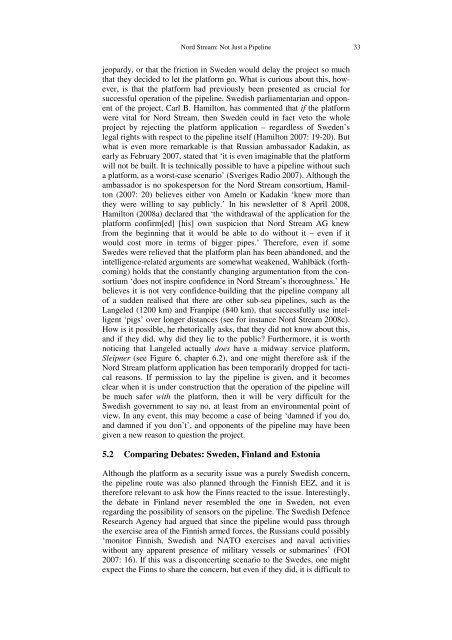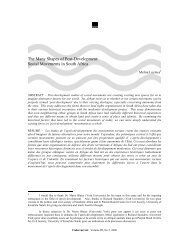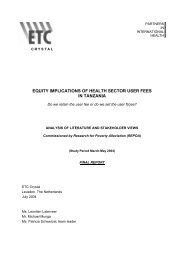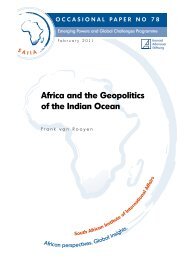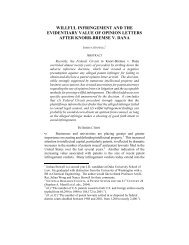Nord Stream: Not Just a Pipeline
Nord Stream: Not Just a Pipeline
Nord Stream: Not Just a Pipeline
You also want an ePaper? Increase the reach of your titles
YUMPU automatically turns print PDFs into web optimized ePapers that Google loves.
<strong>Nord</strong> <strong>Stream</strong>: <strong>Not</strong> <strong>Just</strong> a <strong>Pipeline</strong> 33<br />
jeopardy, or that the friction in Sweden would delay the project so much<br />
that they decided to let the platform go. What is curious about this, however,<br />
is that the platform had previously been presented as crucial for<br />
successful operation of the pipeline. Swedish parliamentarian and opponent<br />
of the project, Carl B. Hamilton, has commented that if the platform<br />
were vital for <strong>Nord</strong> <strong>Stream</strong>, then Sweden could in fact veto the whole<br />
project by rejecting the platform application – regardless of Sweden’s<br />
legal rights with respect to the pipeline itself (Hamilton 2007: 19-20). But<br />
what is even more remarkable is that Russian ambassador Kadakin, as<br />
early as February 2007, stated that ‘it is even imaginable that the platform<br />
will not be built. It is technically possible to have a pipeline without such<br />
a platform, as a worst-case scenario’ (Sveriges Radio 2007). Although the<br />
ambassador is no spokesperson for the <strong>Nord</strong> <strong>Stream</strong> consortium, Hamilton<br />
(2007: 20) believes either von Ameln or Kadakin ‘knew more than<br />
they were willing to say publicly.’ In his newsletter of 8 April 2008,<br />
Hamilton (2008a) declared that ‘the withdrawal of the application for the<br />
platform confirm[ed] [his] own suspicion that <strong>Nord</strong> <strong>Stream</strong> AG knew<br />
from the beginning that it would be able to do without it – even if it<br />
would cost more in terms of bigger pipes.’ Therefore, even if some<br />
Swedes were relieved that the platform plan has been abandoned, and the<br />
intelligence-related arguments are somewhat weakened, Wahlbäck (forthcoming)<br />
holds that the constantly changing argumentation from the consortium<br />
‘does not inspire confidence in <strong>Nord</strong> <strong>Stream</strong>’s thoroughness.’ He<br />
believes it is not very confidence-building that the pipeline company all<br />
of a sudden realised that there are other sub-sea pipelines, such as the<br />
Langeled (1200 km) and Franpipe (840 km), that successfully use intelligent<br />
‘pigs’ over longer distances (see for instance <strong>Nord</strong> <strong>Stream</strong> 2008c).<br />
How is it possible, he rhetorically asks, that they did not know about this,<br />
and if they did, why did they lie to the public? Furthermore, it is worth<br />
noticing that Langeled actually does have a midway service platform,<br />
Sleipner (see Figure 6, chapter 6.2), and one might therefore ask if the<br />
<strong>Nord</strong> <strong>Stream</strong> platform application has been temporarily dropped for tactical<br />
reasons. If permission to lay the pipeline is given, and it becomes<br />
clear when it is under construction that the operation of the pipeline will<br />
be much safer with the platform, then it will be very difficult for the<br />
Swedish government to say no, at least from an environmental point of<br />
view. In any event, this may become a case of being ‘damned if you do,<br />
and damned if you don’t’, and opponents of the pipeline may have been<br />
given a new reason to question the project.<br />
5.2 Comparing Debates: Sweden, Finland and Estonia<br />
Although the platform as a security issue was a purely Swedish concern,<br />
the pipeline route was also planned through the Finnish EEZ, and it is<br />
therefore relevant to ask how the Finns reacted to the issue. Interestingly,<br />
the debate in Finland never resembled the one in Sweden, not even<br />
regarding the possibility of sensors on the pipeline. The Swedish Defence<br />
Research Agency had argued that since the pipeline would pass through<br />
the exercise area of the Finnish armed forces, the Russians could possibly<br />
‘monitor Finnish, Swedish and NATO exercises and naval activities<br />
without any apparent presence of military vessels or submarines’ (FOI<br />
2007: 16). If this was a disconcerting scenario to the Swedes, one might<br />
expect the Finns to share the concern, but even if they did, it is difficult to


